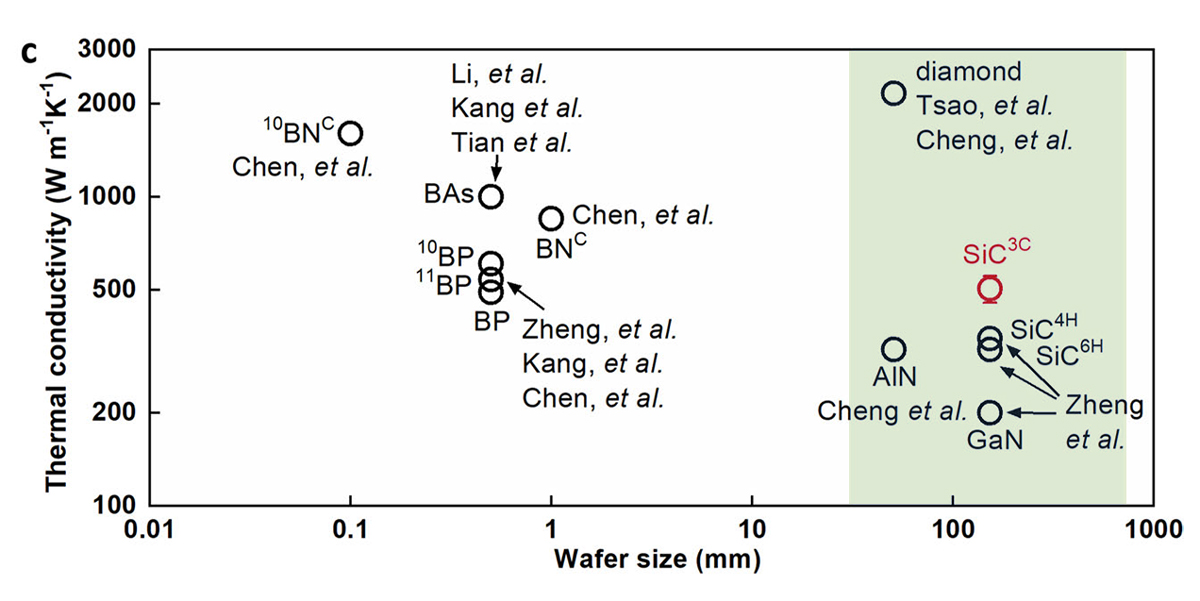Research News
Feb 14, 2023
High thermal conductivity of cubic silicon carbide finally demonstrated
Analysis reveals crystal purity unlocks semiconductor’s thermal conductivity

The measured thermal conductivity of 3C-SiC at room temperature is compared with other high thermal conductivity crystals as a function of wafer size. The shaded portion includes the data from large crystals.
Semiconductors are a key component in smartphones, televisions, and other devices used in daily life using these devices generates heat, resulting in performance degradation and a shorter product life due to the rise in temperature. Therefore, there is a demand for new materials with high thermal conductivity.
Silicon carbide (SiC) is attracting significant attention as a semiconductor material for next-generation power electronics. Generally, the simpler the crystal structure, the higher the thermal conductivity. However, the thermal conductivity of 3C-SiC had not been demonstrated at theoretical levels despite having the second simplest crystal structure after diamond.
A research group, led by Associate Professor Jianbo Liang and Professor Naoteru Shigekawa from the Osaka Metropolitan University Graduate School of Engineering, has proven for the first time that 3C-SiC exhibits high thermal conductivity, equivalent to the theoretical level, based on their thermal conductivity evaluation and atomic-level analysis.
The research group used 3C-SiC crystals developed by Air Water Inc. First, they demonstrated that 3C-SiC crystals exhibit high thermal conductivity among large-diameter materials, where they were second only to diamond. Then, they showed that a thin film of 3C-SiC crystals—one-fiftieth the thickness of a hair—could exhibit a thermal conductivity higher than that of diamond, which also corresponded to the theoretical value.
Next, they performed an atomic-level analysis to investigate why they were able to measure the high thermal conductivity, which had not been previously observed. They found that the 3C-SiC crystal contained almost no impurities: the atoms in the crystal were regularly arranged, indicating a very high-quality single crystal.
Furthermore, they formed 3C-SiC crystals on a silicon substrate and performed an atomic-level analysis of the thermal conductivity of the interface, which revealed no significant disorder in the atomic arrangement at the interface and exhibited a high thermal conductance.
“Both the freestanding 3C-SiC crystal and thin films on a silicon substrate have high thermal conductivity and we expect large-diameter wafers can be fabricated at a low cost. This should lead to improved heat dissipation on a practical level in electronic devices,” concluded Professor Liang.
The research results were published in Nature Communications on November 24, 2022.
Funding
Z.C. and D.G.C. acknowledge the financial support from an endowed position created by the Grainger Engineering Breakthroughs Initiative. Z.C. and D.G.C. thank Guangxin Lyu for help of Raman measurements. The fabrication of the TEM samples was performed at The Oarai Center and at the Laboratory of Alpha-Ray Emitters in IMR under the Inter-University Cooperative Research in IMR of Tohoku University (NO. 202112-IRKMA-0016). The observation of the TEM samples was supported by Kyoto University Nano Technology Hub in the “Nanotechnology Platform Project” sponsored by the Ministry of Education, Culture, Sports, Science and Technology (MEXT), Japan. H.Z., J.T., and T.F. acknowledge the support from National Science Foundation (NSF) (award number: CBET 2212830). The computation used resources of the National Energy Research Scientific Computing Center, a DOE Office of Science User Facility supported by the Office of Science of the U.S. Department of Energy under Contract No. DE-AC02-05CH11231 using NERSC award BES-ERCAP0022132. The support and resources from the Center for High Performance Computing (CHPC) at the University of Utah and the Advanced Cyberinfrastructure Coordination Ecosystem: Services & Support (ACCESS) of NSF are gratefully acknowledged. S.G. acknowledges the financial support from U.S. Office of Naval Research under a MURI program (Grant N00014-18-1-2429).
Paper Information
Journal: Nature Communications
Title: High Thermal Conductivity in Wafer-Scale Cubic Silicon Carbide Crystals
DOI: 10.1038/s41467-022-34943-w
Author: Zhe Cheng, Jianbo Liang, Keisuke Kawamura, Hidetoshi Asamura, Hiroki Uratani, Samuel Graham, Yutaka Ohno, Yasuyoshi Nagai, Naoteru Shigekawa, David G. Cahill
Publish: 23 November, 2022
https://doi.org/10.1038/s41467-022-34943-w
Contact
Graduate School of Engineering
Jianbo Liang
E-mail: liang[at]omu.ac.jp
*Please change [at] to @.
SDGs


